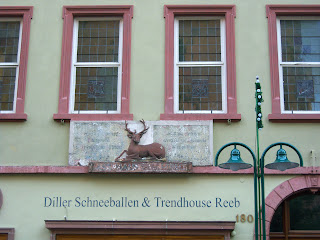Silence-silenzio-stilte-ησυχία-schweigen
Heidelberg
A romantic beauty
22.12.10
The Castle - where the electors held court
Begun as a fortress sometime after 1300, expanded in various architectural styles to a large ensemble, with its Renaissance palaces and gardens, completed by the mid-17th century
Though blown up, fallen into ruin, struck by lightning, destroyed and rebuilt through the years, it still remains imposing to the present day
The Ottheinrich Building - courtyard facade
The Friedrich Building
Studentenkarzer
On Augustinergasse, around the corner from Universitätsplatz, stands the student prison. Heidelberg University exercised legal jurisdiction over its students as they couldn't get punished by the city authorities for offences.
The student would be sentenced to confinement in the University jail for a period from 24 hours to 4 weeks. As time progressed, "doing time" in the Karzer became less and less onerous, indeed it became something of a matter of honour for most students to have experienced at least once while studying in Heidelberg.
The most common offences included disturbing the peace at night by loud singing in the city lanes, inappropriate behaviour in public and participation in illegal fencing duels. Students unwise enough to knock a uniformed local constable's cap off with a stick or to enjoy a good laugh at his expense could also easily end up behind bars.
There was no water supply or cooking facilities in karzer. On the first 2 days of confinement students were given only bread and water. After this, they could have food and even beer brought in from outside if they so desired. The cells were provided with hard beds with straw mattresses. Prisoners had to pay for the use of pillows, covers and sheets or bring their own. The only other furniture comprised a couple of tables and stools.
The students' names for the various rooms included Solitude, Palais Royale and Sanssouci. The "King's Throne" was the fanciful name of the smallest and most private room in the prison.
While "inside" , the students passed their time playing cards, carving their names on tables, visiting fellow-convicts in neighbouring cells and even using a connecting door to enter the University to attend lectures. They spent much of their time decorating the prison's stairway as well as the walls and ceilings of their cells.
Their favourite subjects were silhouette profiles of fellow-students, the coats of arms and monograms of their student associations, the date of their confinement and various humorous comments.
For black paint, they used candle-smuts or soot from the fireplace. As time went on, they brought paints in with them.
Alte Brucke (Karl-Theodor-Brucke)
It withstood all the forces of nature until it was blown up in the last days of the war in 1945. Just one year later it was recovered from the river. Stone for stone. And rebuilt in 1947. Arc for arc. Just as beautiful as 200 years ago.
View from the castle
Once a monkey sat at the northern gate tower of the Old Bridge and held a mirror in front of the people gaping at him. When the bridge and tower were blown up in 1689, the monkey was lost, too. A worthy successor took his place in 1979, next to the bridge gate on the south side.
 |
| Smiling face |
Εγγραφή σε:
Αναρτήσεις (Atom)














































